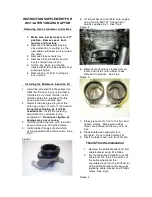
3.2.3 System Working Principle
3.2.3.1 System Working Principle
1. Make Sure Vehicle Smooth Start:
Before start, the vehicle is stationary. If the engine and
transmission has a rigid connection, and once a gear is
engaged, vehicle will suddenly move forward because of the
suddenly transmitted power. It not only will cause mechanical
parts damage, but also the driving force is not enough to
overcome the enormous inertia caused by the forward force,
so that the rapidly decrease in engine speed will shut down the
engine. If a clutch is used when starting, the engine and
transmission will be temporarily separated, and then the clutch
will gradually engage. Due to the sliding between the clutch
driving parts and the driven part, the torque transmitted from
the clutch gradually increases from zero, while the vehicle
driving force gradually increases, so that the vehicle starts
smoothly.
2. Easy to Shift:
During driving, there is a need to frequently switch to different
gears in order to adapt to changing driving conditions. If there
is no clutch to temporarily separate the engine and
transmission, then the transmission meshing gears will be hard
to separate due to the unreleased load. In addition, gears with
different speeds are difficult to mesh. Even if forced into the
mesh, there will be a huge impact on tooth side and cause
damage to parts. The use of the clutch to temporarily separate
the engine and transmission, then the original pair of meshing
gears surfaces pressure will be greatly reduced due to load
released, and are easy to separate. For the other pairs of
meshing gears, because the gear is separated from the engine,
the inertia is small. Use appropriate shifting action to make the
gears meshing circumferential speed to be equal to or close to
equal, so as to avoid or mitigate the impact between gears.
3. Prevent the Transmission System Overload:
During emergency braking, the wheel speed suddenly
decreases. Transmission system is connected to the engine
and has the rotation inertia, so it remains the original speed,
which generates a far greater inertia torque than the engine,
causing damage to the powertrain parts. As the clutch relies on
friction to transmit torque, so when the transmission system
load exceeds the friction torque, the clutch drive parts and
driven parts will skid, thus to prevent the overload .
3-6
Clutch System
Transmission / Drive Axle
EC718/EC718RV EC715/EC715RV 10/2009
Summary of Contents for EC715 2009
Page 4: ......
Page 330: ...Next Step 10 End 2 248 Fuel System JL4G18 D Engine EC718 EC718RV EC715 EC715RV 10 2009 ...
Page 1164: ......
Page 2008: ......
















































